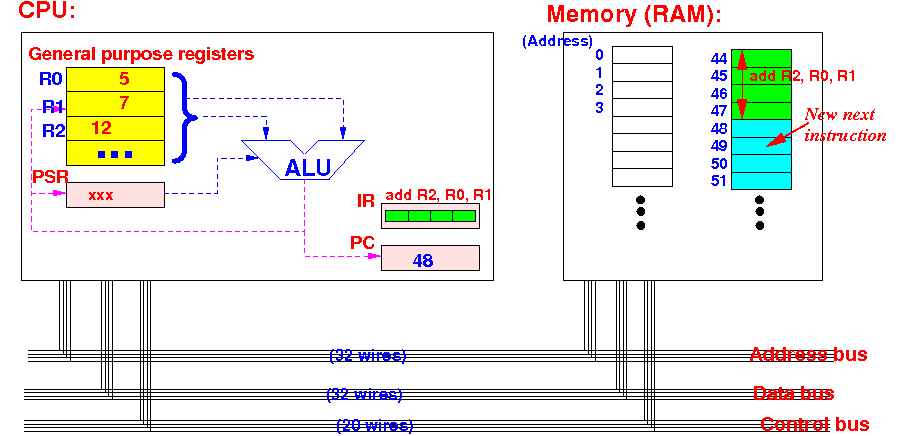- For a concrete example of
the Instruction Execution Cycle,
let's consider the
computer system in
some arbitrary
state:
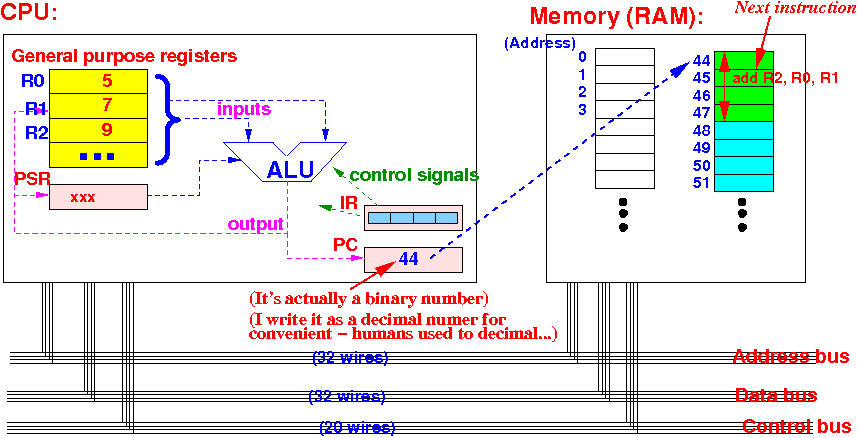
The state above depicts the values that are present in the relevant registers when the CPU starts the Instruction Execution Cycle.
Here are the important information that is given by the CPU state
There are some value in the registers of the CPU and these value are arbitrary -- meaning: you can replace all or any one of them with a different value and the example will remain valid.
The values in the registers are actually binary numbers; but for convenience, I am using their decimal equivalence (remember that you can assign a decimal value to a binary number dndn-1...d1d0 using the formula: dn×2n + dn -1×2n-1 ... + d1×21 + d0 ×20)
The following explains the state information in the above diagram:
- The PC (= Program Counter) register
contains
the value 44
- That means the next instruction
is located at
address 44 in
the memory
- If you look at the memory in the
above diagram, you will see that at
address 44, the memory
contains the
instruction "add R2, R0, R1" --
this is the next instruction that
the CPU will
fetch and execute !!!
In the example, we assume that the instruction code for the instruction "add R2, R0, R1" is represented by 4 bytes --- these 4 bytes are filled with the green color in the diagram.
- The instruction "add R2, R0, R1" means: R2 = R0 + R1 (i.e.: add the values in registers R0 and R1 and store the sum in the register R2).
BTW:
- The instruction that
physically follows the
instruction at address 44 is
the instruction
at address 48 which
is represented by the 4
cyan rectangles (bytes)
in memory
Remember that in the normal (in-order) control flow case, the CPU fetches and executes instructions that physically follows each other
- That means the next instruction
is located at
address 44 in
the memory
- The IR (= Instruction Register) register
contains the previous instruction that
just has been
executed
Explanation:
- We have assumed that the state is
at the start of
an Instruction Execution Cycle....
Therefore: we have just ended the previous Instruction Execution Cycle (because the CPU go through these cycles repeatedly - when one cycle ends, the new one start immediately !!!)
Since we have ended an Instruction Execution Cycle, the instruction in the IR register has just been executed !!
BTW: we don't need the instruction in the IR any more and we don't care what that instruction was. So the IR is filled with 4 blank boxes that represents the "previous instruction".
As you will see in the example later, the instruction in the IR will be over-written
- We have assumed that the state is
at the start of
an Instruction Execution Cycle....
- The PSR (Processor Status Register)
contains some arbitrary value
denoted by
xxx.
This value will not be important in understanding the Instruction Execution Cycle
- The registers
R0, R1, R2 will be important because
the next instruction that
the CPU will execute will
use them as input and output
You can see in the diagram that currently:
R0 contains 5 (again, I used the decimal equivalent for the binary number in R0) R1 contains 7 R2 contains 9
Again, I used the decimal notation because it's convenient -- in reality, these registers contains binary numbers
- The PC (= Program Counter) register
contains
the value 44
Slideshow:
- The Instruction Fetch step will
fetch the instruction located at the
address given in the PC register
(which is the instruction at
memory location 44)
and store it in the
IR register.
The following diagrams show what happens inside the computer system when it performs the Instruction Fetch step:
The CPU first sends out the value of PC on the address bus and the READ signal on the control bus to the memory:
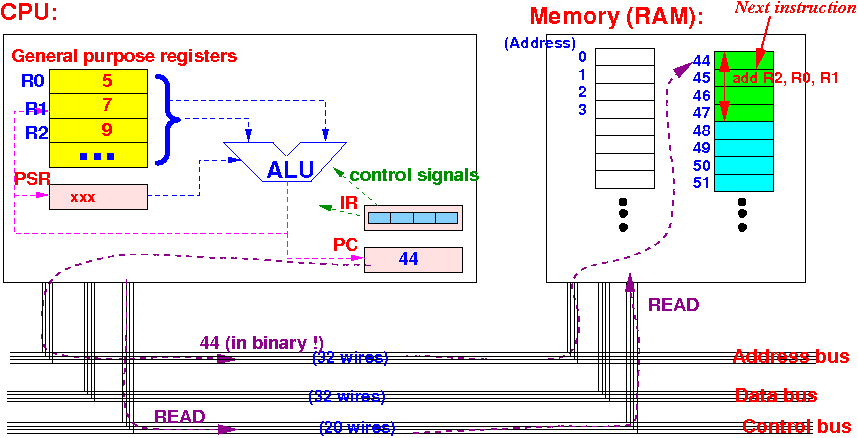
The signals on the address and control buses represents the "send back the data in memory location 44" command to the memory
In response to this command, the memory will send out the content in its memory location 44 on the data bus (wires):
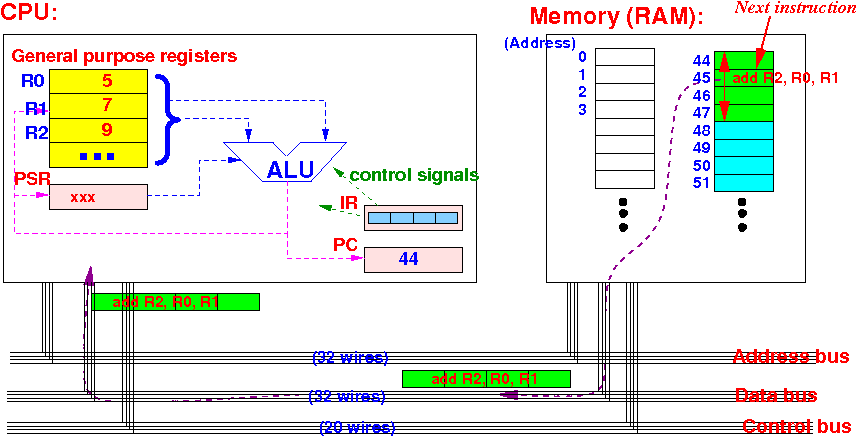
The CPU will then copy the data on the data bus into its IR register (because the CPU is fetching an instruction, it will store the data in its proper place - which is the IR register):
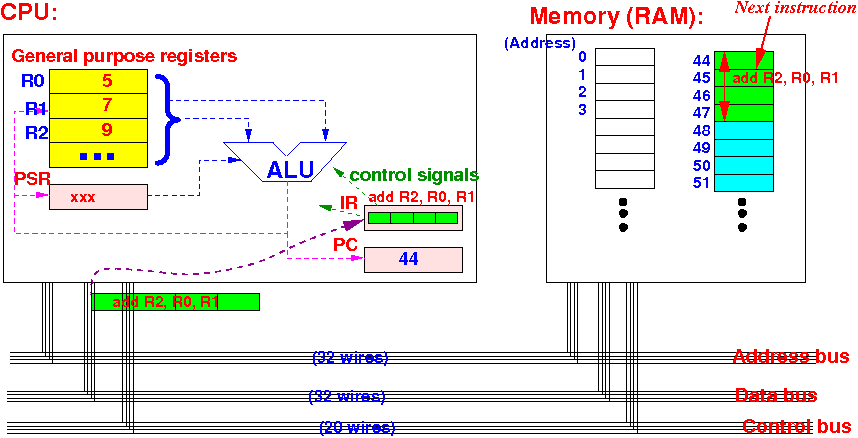
Finally, the CPU updates its PC register to the address of the subsequent instruction (which is 44+4 = 48):
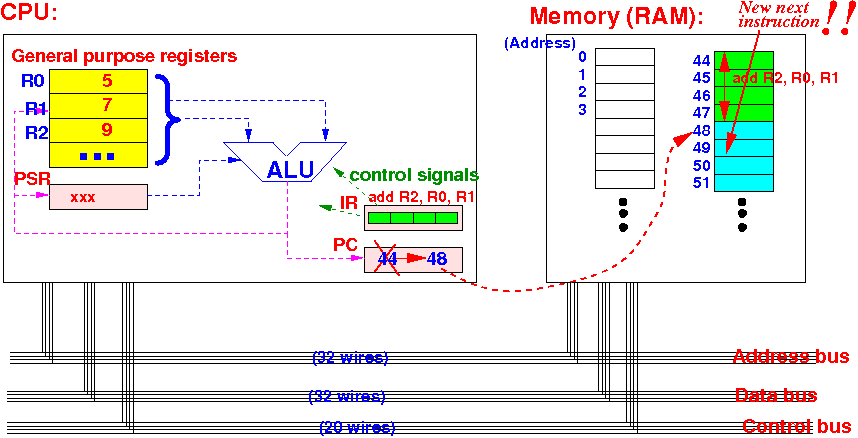
This completes the Instruction Fetch step.
You can see in the diagram that:
- The instruction has been fetched and stored in the IR register
- The PC register now contains the address (location) of a new next instruction - so if the CPU repeats the steps, the CPU will fetch a different instruction !!!
The CPU will continue with the other steps of the Instruction Execution Cycle to execute (= perform the calculation) specified by the fetched instruction
- During the Instruction Decode step,
the CPU will
determine
what the instruction
inside the IR register
tells it to do.
In this example, we used the instruction "add R2,R0,R1"
In a, the IR register contains a binary number and the CPU has to find out what the binary number represent.
The details of this step will be explained in CS355,
For CS255, we just assume that the CPU has discovered that the instruction in the IR register tells the CPU to add the values in register R0 and R1 and store the sum in register R2.
- After the CPU has determined what the instruction tells it to do,
the CPU will fetch the
operands first.
During the Operand Fetch step, the CPU sends out control (electrical) signals to the appropriate registers to tell these registers to send their values to the input of the ALU circuit:

- The IR register will
emit control signals to
tell the
ALU circuit to
perform an
addition on the
input values
The sum is then transmitted to the registers
The IR register will send control signals to register R2 to store the sum:
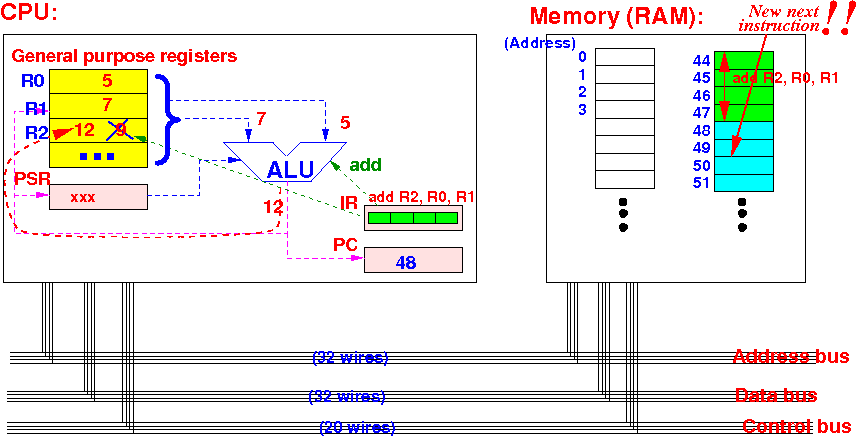
The result is:
- Register R2 will contains the sum (12) of the values in registers R0 (5) and R1 (7)
The Instruction Exection Cycle is now completed and the CPU will repeat the cycle all over again...
|
|
- Remember that the CPU
will go through the
Instruction Execution Cycle
ad infinitum (i.e., forever !)
- Let's take a look at the
state of the
CPU after
finishing the
Instruction Execution Cycle:

What this state is telling us is:
- The CPU will
fetch and execute the
next instruction at
memory location 48
- When this instruction is
fetched, it will
over-write the
"add R2,R0,R1" instruction
in the IR register
(because the "add R2,R0,R1" has been
executed and is no longer needed)
- You can see that when the CPU repeats the Instruction Execution Cycle, it will fetch and execute a different instruction (due to the fact that the CPU updates the PC register after fetching an instruction)
- The CPU will
fetch and execute the
next instruction at
memory location 48
|
|
